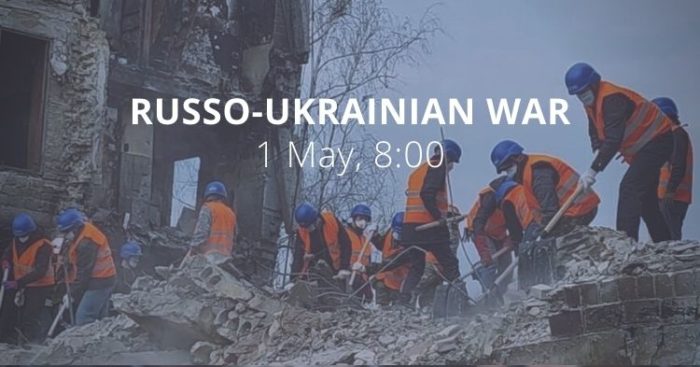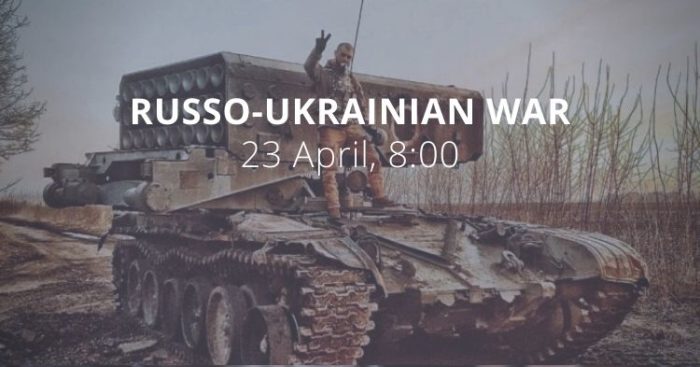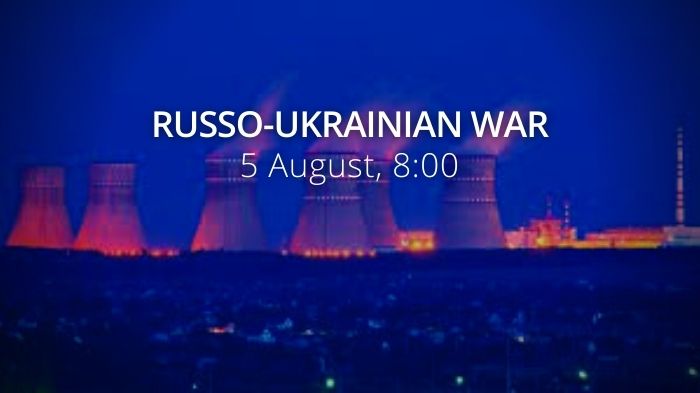Russia launches 83 missiles at Ukraine, kills 14, injures 97. Sweden won't share Nord Stream investigation findings with Russia. 15 Ukrainian oblasts partially cut off from the grid after Russian strikes. More than 1,170 sq km were liberated in the Kherson direction. 7 settlements liberated in Luhansk Oblast. The Russians have been planning missile strikes on the Ukrainian capital and infrastructure since the beginning of October. Russians reload warships with Kalibr missiles and prepare for new air strikes. Ukraine suspends electricity exports to stabilize the energy system. The United States to supply advanced air defense systems for Ukraine. Germany to 'quickly' send air defense systems to Ukraine. Biden, G7 to hold a virtual meeting Tuesday on Ukraine support.
Daily overview — Summary report, October 11
https://twitter.com/EuromaidanPress/status/1579671882088951808
A map of the approximate situation on the ground in Ukraine as of 00:00 UTC 05/07/22. pic.twitter.com/Cg5RdVg18W
— War Mapper (@War_Mapper) July 5, 2022
The General Staff’s operational update regarding the Russian invasion as of 06.00 am, October 11, 2022 is in the dropdown menu below
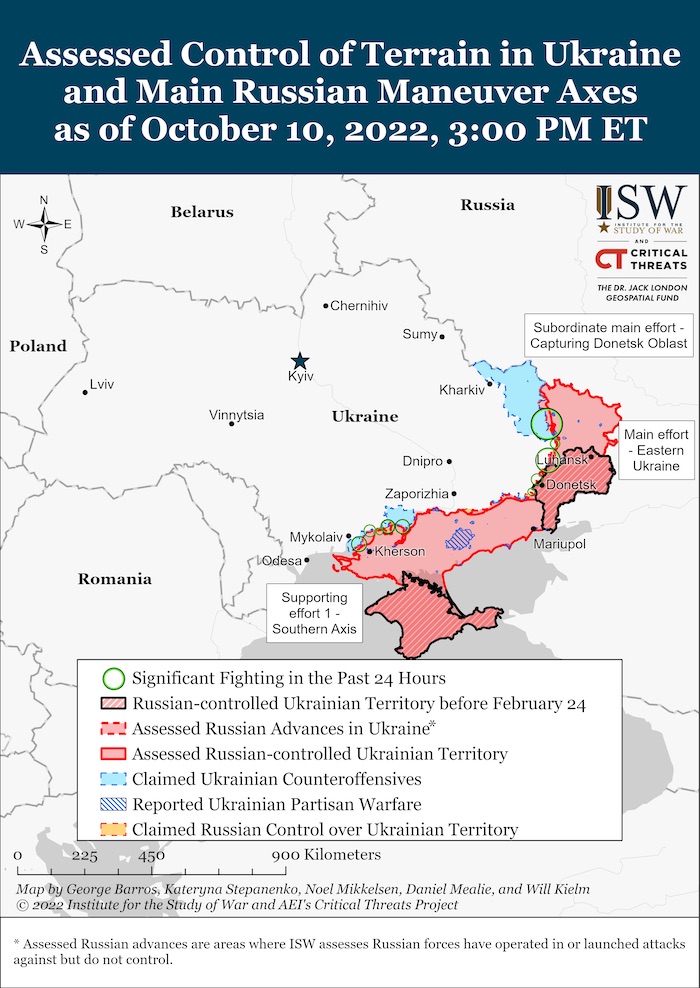
According to information from the General Staff as of 06.00 11.10.2022, supplemented by its [18:00 assessment].
“Without success, Russian forces launches missile strikes and actively uses attack UAVs to damage critical infrastructure and densely populated cities of our country. Russian forces are not able to stop the successful counteroffensive of the Defence Forces in the Kharkiv and Kherson directions, so it is trying to intimidate and sow panic among the population of Ukraine.
[Yesterday, the occupiers launched more than 84 missiles and air strikes. For attacks on cities and villages, Russian forces used cruise, ballistic, anti-aircraft guided missiles and unmanned aerial vehicles.]
During the previous day, the occupiers launched more than 61 missile strikes, 32 airstrikes and about 92 MLRS attacks.
73 air targets were destroyed by air defence units in various directions, including 46 cruise missiles and 27 unmanned aerial vehicles.
As a result of a massive missile attack, the infrastructure of more than 30 settlements was damaged in the past day. These are, in particular, Kyiv, Lviv, Rivne, Zhytomyr, Ternopil, Khmelnytskyi, Ivano-Frankivsk, Vinnytsia, Pryluky, Nizhyn, Konotop, Kharkiv, Kremenchuk, Dnipro, Kryvyi Rih, Zaporizhzhia, Mykolaiv, Odesa. Civilian citizens of Ukraine were killed and wounded.
The threat of Russian missile strikes on critical infrastructure and peaceful neighbourhoods remains.
Also, the occupiers do not stop trying to hold the temporarily captured territories, shell the positions of our troops, focus their efforts on trying to disrupt the counter-offensive actions of the units of the Defence Forces, and try to conduct offensive actions in separate directions.
Mobilization and transfer of reserves by Russian forces also do not provide an opportunity to overcome the resistance of the defenders of our country.
The situation in the Volyn and Polissya directions has not changed significantly. According to available information, the leadership of the Republic of Belarus continues to support the Russian Federation in the war against Ukraine, allowing the Russian Federation to use the airspace and airfield network to carry out airstrikes on the territory of Ukraine. The Defence Forces of Ukraine are monitoring the situation, there are no signs of the formation of offensive groups on the territory of the Republic of Belarus and the movement of troops, as of 06:00 on October 11.
Russian forces fired in other directions:
- in the Siverskyi direction - from mortars, artillery and MLRS, in the areas of Yanzhulivka, Tymonovychi, Mykhalchyna Sloboda of Chernihiv oblast and Bilopillia and Myropillia of Sumy oblast;
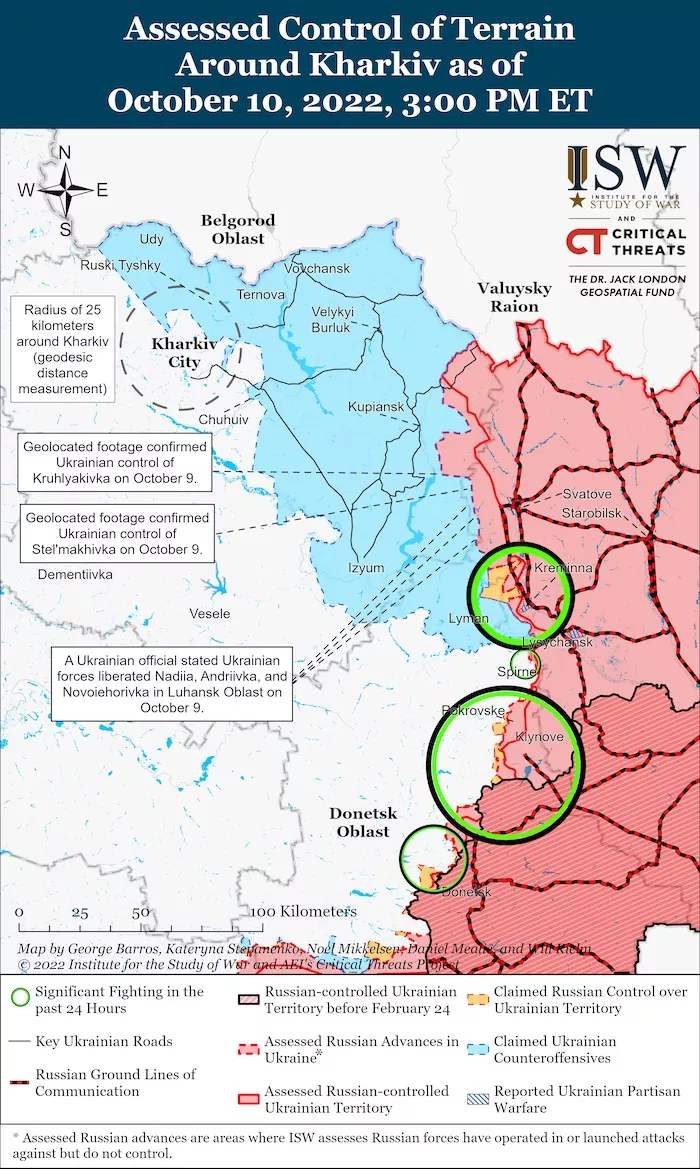
- in the Slobozhansky direction - from artillery and tanks, in the areas of the settlements of Ivashky, Strilecha, Hurivka, Kamianka, Dvorichna, Stelmakhivka, Borshcheva, Sotnytskyi Kozachok, Guryiv Kozachok, Kozacha Lopan, Vilkhuvatka and Chuhunivka;
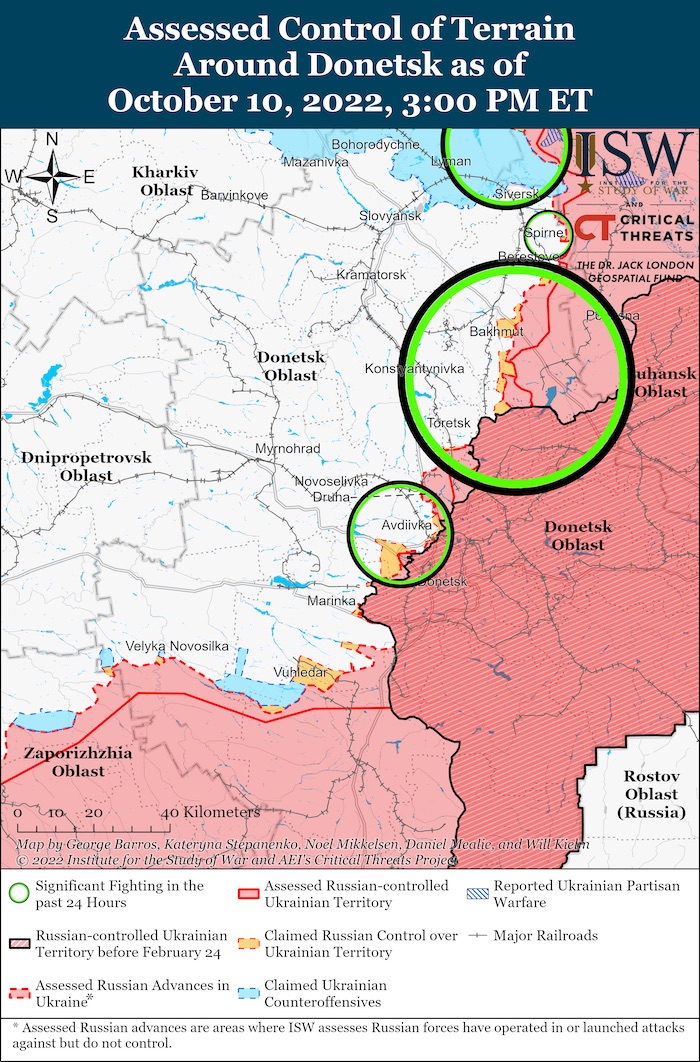
- in the Kramatorsk direction - from tanks, mortars, artillery and MLRS, along the entire line of contact. In particular, in the areas of the settlements of Bilogorivka, Grekivka, Novoyegorivka, Raihorodok, Pershotravneve, Novolyubivka, Makiivka, Nove, Zarichne, Terny, Serebryanka and Hryhorivka;
- in the Bakhmut direction - Russian forces inflicted fire damage in the areas of settlements of Siversk, Soledar, Bakhmut, Bakhmutske, Mayorsk, Kurdyumivka, New York, Krasna Gora, Chasiv Yar, Yakovlivka, Zelenopillia and Odradivka.
- in the Avdiivka, Novopavlivka, and Zaporizhzhia directions - Russian forces did not carry out offensive operations. Avdiivka, Pervomaiske, Vodyane, Krasnohorivka, Mariinka, Novomykhailivka, Vuhledar, Nevelske, Zaliznychne, Bilohirya, Vremivka, Zelene Pole, Novosilka, Shcherbaki, Novopil, Novomykolaivka, Hulyaipilske, Doronka, Temyrivka and Chervonewere shelled by tanks, mortars, barrel and jet artillery.
- In the Pivdennyy Buh direction, Russian forces intensified shelling from tanks and artillery of various types. Areas of the settlements of Vyshchetarasivka, Novokyivka, Pravdyne, Myrne, Ternovi Pody, Lyubomirivka, Shyroke, Kiselivka, Chervona Dolyna, Blahodativka, Davydiv Brid and Nova Kamianka were affected by the fire.
Over the past day, units of the Defence Forces of Ukraine repelled the attacks of the occupiers in the areas of the settlements of Bakhmut, Bakhmutske, Mayorsk, Soledar and Pervomaiske.
Russian forces continue to suffer losses. So, on October 9 of this year, in the area of Bilozerka, Kherson oblast, our soldiers destroyed about 15 units of enemy military equipment. On October 10, in the area of Beryslav settlement, a hangar with military equipment of Russian forces was hit, the losses are being clarified.
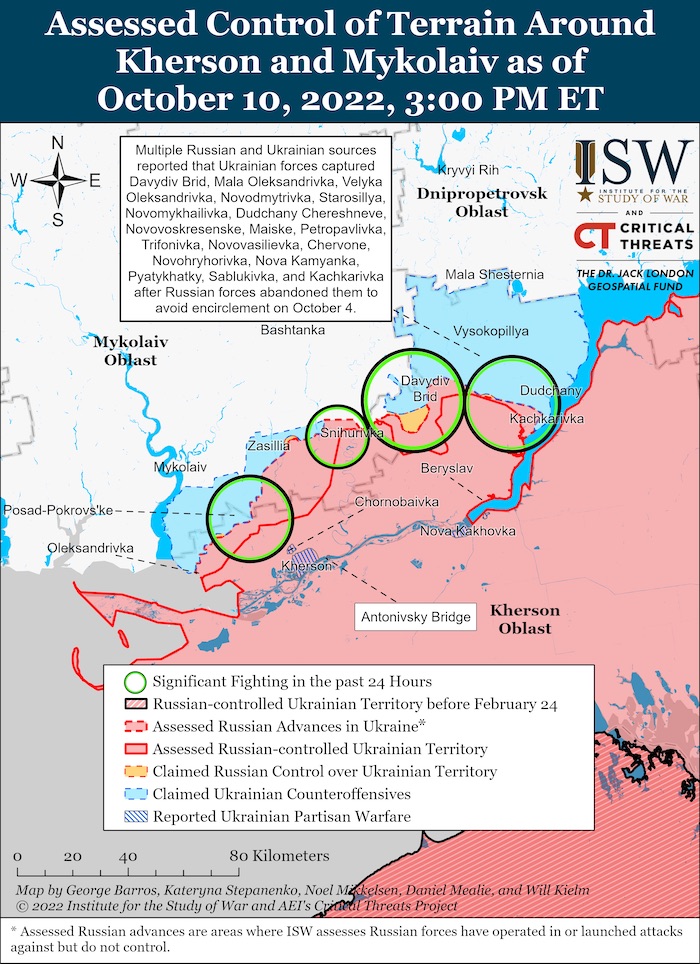
[Russian forces continue to suffer losses. According to detailed information, as of October 9, the battalion tactical group of Russian forces from the 150th motorized rifle division, operating in the Kherson direction and consisting mainly of demobilized servicemen, has already lost more than 520 people killed.]
[To meet the needs of hospitals in temporarily occupied settlements, which are actively used by the invaders as hospitals, additional groups of medical workers arrive. In the children's hospital of one of the settlements of Luhansk oblast, the Russian occupiers placed their wounded, along with sick children. Among them are former prisoners, and representatives of the private military campaign "Wagner". There are rare cases when children are not treated and discharged to free up beds.]
[At the same time, Russian forces continue to cover themselves with the population of the temporarily occupied territories, as a human shield. Thus, in some educational institutions of the Yasynuvata district of the Donetsk oblast, at the same time as the educational process, servicemen of units of the Russian occupation forces continue to be accommodated.]
The aggressors recommend to teachers of universities in Kherson who cooperate with the occupation authorities to move to the territory of Crimea. It is also known that in the event of a "complication" of the situation in the temporarily occupied territory of Ukrainian Crimea, the occupying authorities have plans to evacuate the families of representatives of the leadership of the security forces serving in the said territory.
In the city of Starobilsk, Luhansk oblast, the occupiers are searching for Ukrainian patriots, detaining family members and friends of military personnel, as well as law enforcement officers.
In addition, according to available information, in the Luhansk oblast, under the guise of searching for Ukrainian saboteurs, the invaders are looking for their deserters.
Aviation of the Defence Forces carried out 6 strikes during the past 24 hours. It has been confirmed that 4 places of concentration of weapons and military equipment, as well as 2 enemy anti-aircraft missile systems, have been destroyed. In addition, air defence units destroyed an enemy Su-25 aircraft.
Over the previous day, missile forces and artillery hit the command post, four areas of concentration of manpower, weapons and military equipment, one S-300 anti-aircraft missile system of Russian forces and one warehouse with ammunition.“
Military Updates
Russians spent $400-700 mn on massive attacks in Ukraine on October 10
Russia launched 84 cruise missiles and 24 drones at the territory of Ukraine as of 17:00. Ukrainian troops shot down more than half – 43 and 13 UAVs.https://t.co/R4aFiJb6Oo
— Euromaidan Press (@EuromaidanPress) October 11, 2022
The morning is difficult. We are dealing with terrorists, President Zelenskyy stated. “Dozens of missiles, Iranian Shahed [drones]. They have two targets. [Russian targets are] energy facilities, all across the country. Kyiv Oblast and Khmelnytskyi Oblast, Lviv and Dnipro, Vinnytsia, Ivano-Frankivsk Oblast, Zaporizhzhia, Sumy Oblast, Kharkiv Oblast, Zhytomyr Oblast, Kirovohrad Oblast, the south. They want panic and chaos, they want to destroy our energy system. They are hopeless.
The second target is people. Such a time and such targets were specially chosen to cause as much damage as possible. […] Always remember: Ukraine was before this enemy appeared, Ukraine will be after him.”
https://twitter.com/EuromaidanPress/status/1579653259442106368
Ukraine's Air Force explains how Russia struck on 10 October and where from, Ukrainska Pravda reports. “Russia used high-precision missiles in its massive missile attack against Ukraine on 10 October. So far today 83 missiles have flown over our country; as of 11:40, more than 43 missiles have been shot down. […]
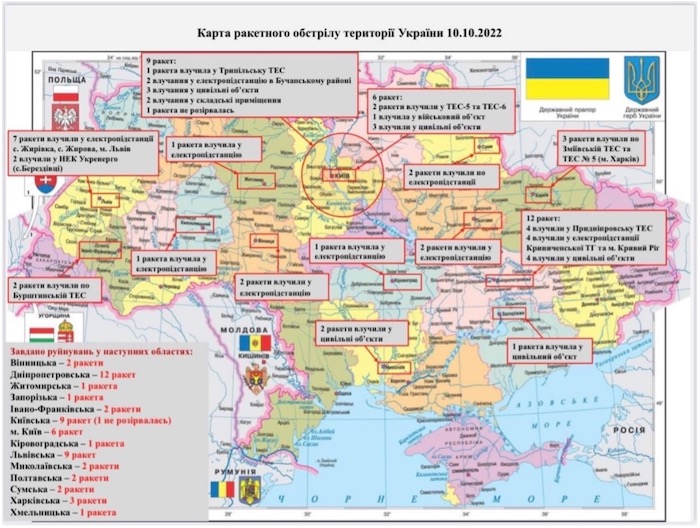
Russian forces use high-precision Kh-101 and Kh-555 missiles, which are launched from strategic bombers from the Caspian region, Kalibr missiles from the Black Sea, as well as Iskander, S-300 and Tornado [missiles]. […] Russian planes take off from the Astrakhan area, fly to the north of the Caspian Sea and launch missiles from there.
The air defence system shot down nine out of twelve Shahed-136 kamikaze drones detected in Ukrainian skies on 10 October.”
The Russians have been planning missile strikes on the Ukrainian capital and infrastructure since the beginning of October, the Defence Intelligence of Ukraine (DIU) reports. “According to DIU, the Russian occupying forces received instructions from the Kremlin to prepare massive missile strikes on Ukrainian civilian infrastructure on October 2 and 3. Military units of strategic and long-range aviation received orders to prepare for the task of massive missile attacks. The objects of critical civil infrastructure and the central areas of densely populated Ukrainian cities were identified as targets.
On October 8, seven Tu-160 strategic bombers were transferred from the Engels airfield to the "Olenya" airfield and equipped with Kh-101 cruise missiles.
6 cruise missile carriers with 40 Kalibr missiles were deployed on the external raid from Sevastopol.
The main goal of the terrorist country was to destroy the Thermal Power Plants, create panic among Ukrainians and intimidate the European public.”
Russians reload warships with Kalibr missiles and prepare for new air strikes, Ukrainska Pravda reports. “Vitalii Kim, the head of the Mykolaiv Oblast Military Administration, has reported that the Russian occupiers have reloaded their warships in the Black Sea with Kalibr high-precision missiles and are getting their long-range aircraft in Astrakhan ready for new strikes on Ukraine.”
More than 1,170 sq km were liberated in the Kherson direction, Ukrinform reports. "As of today, more than 1,170 sq km have been liberated in the Kherson direction since the beginning of active operations. Work is ongoing to gain a foothold in the territories, mop them up, and carry out stabilization measures, Natalia Humeniuk, Spokesperson for the Operational Command "South", announced.
At the same time, the local residents are advised not to return immediately to the liberated territory as the invaders' have mined buildings, infrastructure facilities, roads, and fields while retreating. In addition, cluster munitions are scattered during strikes.»
Names of 7 settlements liberated in Luhansk Oblast made public, Ukrainska Pravda reports. “Sergii Haidai, the Head of the Luhansk Oblast Military Administration, has named 7 settlements that were recently liberated by the Armed Forces of Ukraine in Luhansk Oblast. At the moment, seven following settlements are fully controlled by Ukraine:
the village of Novoliubivka of the Krasnorichensk village hromada [an administrative unit designating a town, village or several villages and their adjacent territories – ed.]; the village of Nevske of the Krasnorichensk village; the village of Hrekivka of the Krasnorichensk village; the village of Novoiehorivka of the Kolomyichykha village; the village of Nadiia of the Kolomyichykha village; the village of Andriivka of the Kolomyichykha village; and the village of Stelmakhivka of the Kolomyichykha village (all hromada in the Svatove district).
On 7 October, President Volodymyr Zelenskyy reported that this week, the Armed Forces of Ukraine liberated 776 square kilometres of the territory, or 29 settlements, six of them in Luhansk Oblast.”
https://twitter.com/EuromaidanPress/status/1579600159410769920
According to British Defence Intelligence, (last 48 hours):
- On 08 October 2022, the Russian Ministry of Defence (MOD) announced that General Sergei Surovikin had been appointed as overall commander of its Joint Group of Forces conducting the ‘special military operation’ in Ukraine. Surovikin has previously commanded the Russian Aerospace Forces and, more recently, the Southern Grouping of Forces on operations in Ukraine.
- For much of its operation, Russia has likely lacked a single empowered field commander. General Alexandr Dvornikov likely held the role for a period between April and August 2022, but it is unclear whether he was able to effectively exercise control over the often disparate and competing groupings of forces.
- Surovikin’ s appointment likely reflects an effort by the Russian national security community to improve the delivery of the operation. However, he will likely have to contest with an increasingly factional Russian MOD which is poorly resourced to achieve the political objectives it has been set in Ukraine.
- Ukrainian offensive operations continue to place pressure on Russian forces both in the north-east and in Kherson Oblast in the south. However, Russia continues to give high priority to its own offensive operations in the central Donbas sector, especially near the town of Bakhmut.
- Over the last week Russian forces have advanced up to 2km towards the town on two axes, coming closer to breaking into Bakhmut, which has suffered very extensive damage from shelling. These forces have likely included Wagner private military company units, including personnel recently recruited from Russian prisons.
- Russia’s continued efforts to progress its grinding Donbas offensive, in the face of serious threats on its operational flanks highlight the imperative to deliver operational success while also underlining the inflexible operational design which has undermined its plans thus far.
Losses of the Russian army
As of Tuesday 11 October, the approximate losses of weapons and military equipment of the Russian Armed Forces from the beginning of the war to the present day:
- Personnel – more than 63110 (+240),
- Tanks – 2504 (+9),
- Armoured combat vehicles – 5162 (+13),
- Artillery systems – 1496 (+10),
- Multiple rocket launchers –MLRS - 353 (+0),
- Air defence means – 181 (+0),
- Aircraft - 268 (+1),
- Helicopters - 235 (+0),
- Automotive technology and fuel tanks – 3916 (+8),
- Vessels/boats - 15 (+0),
- UAV operational and tactical level – 1114 (+17),
- Special equipment – 136 (+0),
- Mobile SRBM system – 4 (+0),
- Cruise missiles – 295 (+46)
Russian enemy suffered the greatest losses (of the last day) in the Bahmut, Аvdiyivka and Kramatorsk directions.
Putin doesn't have many missiles left – National Security Council of Ukraine, Ukrainska Pravda reports, citing Oleksii Danilov, the Secretary of the National Security and Defence Council. "Regarding today’s massive missile attack on almost every region in Ukraine at once, [including the strikes] on our energy system: this is a sign of weakness, a sign that he [Putin - ed.] realises that he is losing. He wants to wreak havoc, and panic by doing this.
But I would like to calm all our citizens down and say that he doesn’t have that many missiles left, and he will run out of them completely sooner or later. We know for sure that there are significantly fewer of them than [there were] before 24 February."
⚰️russia's combat losses in Ukraine as of October 11
▪ 63110 killed soldiers (+240)
▪ 5162 APV (+13)
▪ 2504 tanks (+9)
▪ 1496 artillery systems (+10)
▪ 268 aircraft (+1) and 235 helicopters
▪ 15 boats and cutters#StopRussia #StandWithUkraine pic.twitter.com/4i8ashxg5B— VoxUkraine (@voxukraine) October 11, 2022
Humanitarian
If Russia is not a terrorist state, then what is?
Here are our reasons why Russia should be designated a state sponsor of terrorism:https://t.co/0BwrDXO9qz pic.twitter.com/zEYRdjplXO
— Euromaidan Press (@EuromaidanPress) October 10, 2022
Russian missile strikes on 10 October: Ministry of Internal Affairs confirms 14 people killed, Ukrainska Pravda reports, citing Denys Monastyrskyi, Minister of Internal Affairs of Ukraine. "This is the second attack on this scale since 24 February. From the point of view of critical energy infrastructure, this must be the largest such attack in modern history. We can now call this attack energy terrorism. In my opinion, it was just an extension of [Russia’s] nuclear terrorism at the nuclear power plant, I mean the Zaporizhzhia NPP, which the Russian forces shelled relentlessly.
There were attacks on 12 different oblasts. As of now, we have recorded a total of 74 attacks, and sadly we have confirmed the deaths of 14 people; another 97 people sustained injuries.
Monastyrskyi said that Ukraine expects to restore the damage to its energy infrastructure within the next 24 hours. He added that 30 fires caused by Russia’s missile strikes on Ukraine have been extinguished. As of now, 1,300 cities, towns and villages continue to experience power outages.
Four [coal] mines have been left without power in Dnipropetrovsk Oblast; 854 miners were there at the time of the Russian attack. A total of 118 of them remain underground; a rescue operation to get them out is underway.”

OHCHR recorded 15,592 civilian casualties in Ukraine as of October 10. 6,221 were killed (including 396 children) and 9,371 injured (including 714 children).
Environmental
15 Ukrainian oblasts partially cut off from grid after Russian strikes — State Emergency Service, Ukrainska Pravda reports, citing State Emergency Service of Ukraine. "As a result of the shelling on 10 October, critical infrastructure facilities have been hit in 12 oblasts and the city of Kyiv; more than 30 fires broke out [in the capital city].
15 oblasts have been left partially without electricity (Lviv, Ivano-Frankivsk, Chernivtsi, Khmelnytskyi, Zhytomyr, Vinnytsia, Kyiv, Kirovohrad, Mykolaiv, Dnipropetrovsk, Zaporizhzhia Poltava, Kharkiv, Sumy and Ternopil oblasts) and the city of Kyiv."
Ukraine suspends electricity exports to stabilize the energy system, Ukrinform reports, citing the Ministry of Energy. "Today's missile attacks, which affected the thermal power generation and electrical substations, have forced Ukraine to suspend electricity exports from October 11 to stabilize the energy system.
The ministry stressed that Russia continues to carry out energy terror against Ukraine and increases energy pressure on the European Union.”
Legal
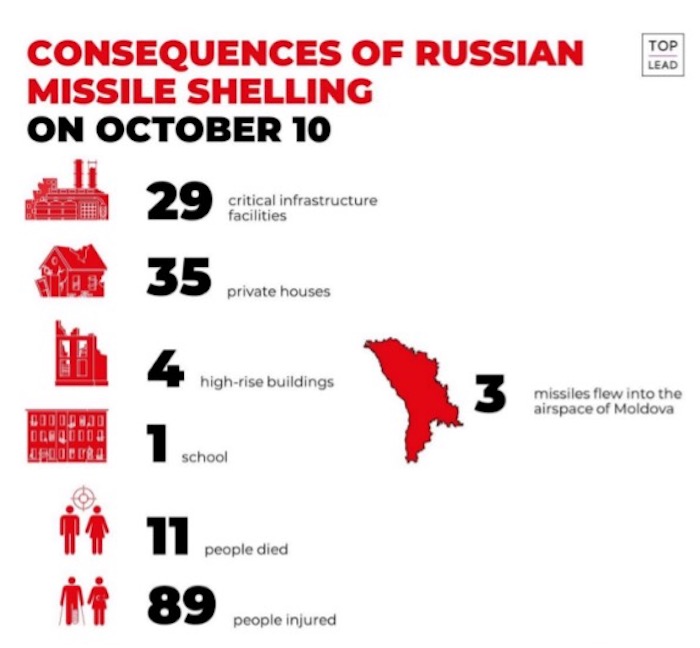
Russian mass rocket attack on 10 October: [14] dead and [97] people injured, Ukrainska Pravda reports, citing Ihor Klymenko, Chief of the National Police of Ukraine. "The most massive attack on Ukraine [since the beginning of the full-scale war]: Russia continues to show the world its terrorist essence. The Russian rockets killed 11 people. […] According to the police, so far 87 people have been injured in the Russian rocket attacks across Ukraine, including employees of the National Police of Ukraine.
Many passengers of the Dnipro bus were, however, injured mostly by shattered windows while its driver was in the intensive care unit https://t.co/8FVcGbfg5k
In total, 3 were killed by Russian attacks on Dnipro, 20 were injured. https://t.co/WSUYSPn5cG— Euromaidan Press (@EuromaidanPress) October 10, 2022
An estimated 70 facilities are known to have been damaged, including 29 critical infrastructure facilities, 4 high-rise buildings and 35 private residential buildings, as well as a school in Kyiv.
Over 80 investigative and operational police task forces are working at the sites of the strikes. Mobile forensic laboratories are being used to document war crimes.”
Sweden won't share Nord Stream investigation findings with Russia – PM, Reuters reports. “Sweden won't share findings of the investigation into the explosions of the Nord Stream gas pipelines with Russian authorities or Gazprom, Swedish Prime Minister Magdalena Andersson said on Monday. A Swedish crime scene investigation of the Nord Stream 1 and 2 gas pipelines from Russia to Europe has found evidence of detonations and prosecutors suspect sabotage.
Last week Russian Prime Minister Mikhail Mishustin sent a letter to the Swedish government demanding that Russian authorities and Gazprom would be allowed to be involved in the investigation, which Sweden denied.
On Monday Andersson said Sweden won't even share the findings of the explosions that took place in the Swedish economic zone, with Russian authorities. In Sweden, our preliminary investigations are confidential, and that, of course, also applies in this case, she told reporters.”
Possible extension of Germany's nuclear power at risk -econ ministry, Reuters reports. “The German government on Monday failed to approve a draft law to put on reserve two of the country's last nuclear power plants beyond their planned phase-out due to political disagreements, the Economy Ministry said, complicating Berlin's energy plans for the winter. Germany had planned to complete a phase-out of nuclear power by the end of this year, but a collapse in energy supplies from Russia because of the war in Ukraine has prompted the government to keep two plants on standby until April.
But disagreements within the German cabinet could jeopardize the possible lifespan extension for the Isar II power plant, a spokesperson for the Economy Ministry told Reuters.”
422 children were killed, 805 children injured, 8,140 deported by foe forces, and 242 reported missing - the Office of the Prosecutor General of Ukraine reports as of October 11. 2,614 educational establishments are damaged as a result of shelling and bombings, 313 of them are destroyed fully. 39,347 crimes of aggression and war crimes and 17,433 crimes against national security were registered.
Support
https://twitter.com/EuromaidanPress/status/1579675657524711424
The United States to supply advanced air defense systems for Ukraine – White House, Ukrinform reports. “The United States will continue providing Ukraine with the support needed to defend itself, including advanced air defense systems.
The relevant statement was made by United States President Joseph Biden in a phone call with Ukrainian President Volodymyr Zelensky, an Ukrinform correspondent reports, referring to the White House.”
Germany to 'quickly' send air defense systems to Ukraine, DW reports. “Germany is set to deliver the first of four high-tech air defence systems within "days." The rush to move up the delivery comes after heavy Russian missile strikes hit major Ukrainian cities including Kyiv. German Defense Minister Christine Lambrecht on Monday said Russian missile attacks on Ukrainian population centres highlighted the urgency of delivering air defense systems to Kyiv's forces.
The long-promised systems, which are capable of “protecting an entire city”, were originally slated to be delivered at the end of the year. Monday's deadly strikes, however, have now sped up the delivery timeline.”
Biden, G7 to hold a virtual meeting Tuesday on Ukraine support - White House, Reuters reports. “US President Joe Biden and Group of Seven (G7) leaders will hold a virtual meeting on Tuesday to discuss their commitment to support Ukraine and hold Russian President Vladimir Putin accountable for Russia's aggression, including its recent missile strikes across Ukraine, the White House said.”
New Developments
- [After having launched 83 missiles against Ukrainian cities] Putin threatens Ukraine with a "harsh response" in event of "terrorist attacks" on Russia's territory, Ukrainska Pravda “Russian President Vladimir Putin has threatened Ukraine with a "harsh response" in case of attempts to carry out "terrorist attacks" on the territory of the Russian Federation, as he commented on the morning missile attack on Ukraine.”
- Liz Truss will request an urgent meeting of NATO leaders, Ukrinform “UK Prime Minister Liz Truss will request an urgent meeting of NATO leaders over Russia’s missile attacks on Ukraine.”
- Russia vows to respond to greater Western involvement in Ukraine, Reuters “Russia will respond to the West's growing involvement in the Ukraine conflict although direct conflict with NATO is not in Moscow's interests, Russia's deputy foreign minister said on Tuesday after Washington pledged more military aid for Kyiv. "We warn and hope that they realise the danger of uncontrolled escalation in Washington and other Western capitals," Russian Deputy Foreign Minister Sergei Ryabkov was quoted as saying by RIA news agency on Tuesday.”
https://twitter.com/EuromaidanPress/status/1579630359989436418
- Ukraine’s Foreign Minister: Western partners no longer talking about negotiations with Russia after this morning’s missile strikes, Ukrainska Pravda "No one has dared to [mention negotiations with Russia]. Though we are diplomats, lately we just shut people up as soon as they mentioned negotiations. Because there is only one thing to be said after what Russia has done: Russia’s missiles are Russia’s negotiating position. This is what we say loud and clear to those countries that try to tell us [to negotiate with Russia]."
- Deputy Head of Russia's Security Council announces new strikes on Ukraine, Ukrainska Pravda Dmitry Medvedev, the Deputy Head of Russia’s Security Council, said that Russia is preparing new mass strikes on Ukraine’s cities. "The first act is over. There will be more." Medvedev repeated the Kremlin’s narratives regarding Ukraine’s allegedly "Nazi political regime", which "poses a constant, direct and clear threat to Russia”. That is why, in addition to protecting our people and guarding the borders of our country, the aim of our future actions must be to fully dismantle Ukraine’s political regime, Medvedev stated.”
https://twitter.com/EuromaidanPress/status/1579604685463646208
- One of the diplomatic missions in Kyiv was damaged after Russian attacks, European Pravda "Following Russian missile and drone attacks on the centre of Kyiv this morning, some damage to the main headquarters of the European Union Advisory Mission suffered occurred, the mission reported. At the moment, there are no reports of casualties among the mission employees.”
- Russia will be held accountable for its atrocities and war crimes – Biden, Ukrinform reports, citing a statementby President Biden. “The United States strongly condemns Russia’s missile strikes today across Ukraine, including in Kyiv. These attacks killed and injured civilians and destroyed targets with no military purpose, he said. Biden stressed that the recent attacks once again demonstrate the utter brutality of Putin’s illegal war on the Ukrainian people. These attacks only further reinforce our commitment to stand with the people of Ukraine for as long as it takes. Alongside our allies and partners, we will continue to impose costs on Russia for its aggression, hold Putin and Russia accountable for its atrocities and war crimes, and provide the support necessary for Ukrainian forces to defend their country and their freedom.”
- Council of Europe condemns Russian attacks on Ukrainian cities, Ukrinform "We strongly condemn the Russian air strikes against towns and cities in Ukraine in the last two days which led to multiple civilian casualties, including many children, as well as the destruction of civilian infrastructure. Such indiscriminate attacks demonstrate blatant disregard for human life and constitute serious violations of international humanitarian law. Ireland’s Minister for Foreign Affairs and Chair of the Council of Europe’s Committee of Ministers, Simon Coveney, the President of the Parliamentary Assembly of the Council of Europe, Tiny Kox, and the Secretary General of the Council of Europe, Marija Pejčinović Burić, said this in a joint statementposted on the Council of Europe's website.”
- No, Putin was not “provoked” to unleash missile terror by Crimea Bridge, Ukrainian Minister of Foreign Affairs, Dmytro Kuleba, stated. “Russia had been constantly hitting Ukraine with missiles before the bridge, too. Putin is desperate because of battlefield defeats and uses missile terror to try to change the pace of war in his favour. This nonsense about Putin being “provoked” must stop. He does not need anything to “provoke” him in order to commit heinous crimes. I ask international media to stop shifting the blame on the victim of aggression by suggesting that Putin responds or is being provoked”.
https://twitter.com/EuromaidanPress/status/1579645457856311296
- Lukashenka decides that state security agencies should submit only to him, Ukrainska Pravda reports, citing the website of the President of Belarus. “Belarusian state security bodies will now submit only to Aliaksandr Lukashenka, self-proclaimed President of the country.”
Assessment
- On the war.
map source: https://www.understandingwar.org/backgrounder/russian-offensive-campaign-assessment-october-10*
The Institute for the Study of War has made the following assessment as of 11 October, 2022:
“Eastern Ukraine: (Oskil River-Kreminna Line)
Ukrainian forces continued offensive operations in western Luhansk Oblast east of the Oskil River in the direction of Svatove and Kreminna on October 9 and 10 and have likely liberated over 200 square kilometers of territory in western Luhansk Oblast as of October 10. Ukrainian forces captured Stel'makhivka (17 kilometers west of Svatove) on October 9, and Luhansk Oblast Administration Head Serhiy Haidai confirmed that Ukrainian forces liberated several settlements on the Oskil River-Kreminna Line including Novolyubivka, Nevske, Hrekivka, Novoiehorivka, Nadiia, and Andriivka. Geolocated combat footage posted on October 9 shows Ukrainian forces destroying a Russian tank in Novoselivske 15 km northwest of Svatove on the Svatove–Kupiansk highway. […] A Russian milblogger claimed that Russian forces counterattacked and recaptured Terny on October 10, though ISW cannot verify this claim. ISW’s assessment of Ukrainian forces’ front line places Ukrainian forces within 20 km of Svatove’s western side.
Russian forces are likely preparing defenses in Starobilsk and Svatove in response to Ukraine’s northern counter-offensive. A Russian milblogger reported that the Wagner Group deployed approximately 1,000 personnel to the Russian force grouping in Lysychansk to reinforce the Luhansk sector and establish a defensive line that will run from Lysychansk along the Siverskyi Donets River back to Russian’s internationally recognized borders on October 9. Social media video reportedly shows Russian forces in Starobilsk forcing students to dig trenches on October 9. Haidai reported that Russian forces blew up railway and bridge crossings near Svatove, are laying mines, and continued to prepare defenses in the area on October 10.
Southern Ukraine: (Kherson Oblast)
Russian forces continued their unsuccessful attempts to regain lost positions in northern and northwestern Kherson Oblast on October 9 and October 10. Ukraine’s Southern Operational Command stated that Russian forces up to the size of a motorized rifle platoon unsuccessfully attempted to attack Ukrainian positions in the direction of Davydiv Brid on the eastern bank of the Inhulets River. Ukrainian military officials noted that Russian forces focused most of their airstrikes on Davydiv Brid and struck Ukrainian positions with kamikaze drones in Dudchany (on the western bank of Dnipro River) and other liberated settlements. Russian sources claimed that Davydiv Brid “is a grey zone” and stated that Russian forces are clearing the forest belt south of Davydiv Brid, however. […] Russian milbloggers claimed that Russian forces attempted to launch a counterattack on Ternovi Pody, approximately 33km northwest of Kherson City.
Russian forces are maintaining their efforts to reinforce positions with hastily mobilized and damaged units in northern Kherson Oblast. Ukraine’s Southern Operational Command reported that Russian forces transferred an additional 200 servicemen and up to 300 units of military equipment to reinforce areas of Ukrainian counter-offensives, but these forces are likely not sufficient for Russian forces to regain lost positions in northern Kherson Oblast. Russian sources also reported that mobilized men from Volgograd Oblast and the Republic of Kalmykia arrived in Kherson Oblast. The Ukrainian General Staff claimed that a battalion tactical group (BTG) of the 150th Motorized Rifle Division that operates in the Kherson direction had over 520 servicemen killed in action, which would be more than half of the nominal complement of personnel in a motorized rifle BTG. The report noted that the BTG largely consists of mobilized men, which is likely considering that ISW has previously reported that 150th Motorized Rifle Division had suffered serious losses during the Battle of Mariupol. The Ukrainian General Staff reported that the Donetsk People’s Republic‘s (DNR) 127th Rifle Regiment of the 1st Army Corps has suffered critical losses after serving on the first line of combat in Kherson and Mykolaiv Oblasts and that their families complained to Russian law enforcement about failures by the Russian military command to support them and about their poor living conditions. The Ukrainian General Staff noted that an unspecified commander of the Russian 49th Combined Arms Army formed the 127th Rifle Regiment without necessary preparation or proper equipment. ISW previously reported that this unit is composed of forcefully mobilized men and has previously refused to fight due to lack of such basic supplies as water in early September.
Ukrainian forces continued to conduct an interdiction campaign in Kherson Oblast on October 9 and October 10. Ukraine’s Southern Operational Command reported that Ukrainian forces destroyed three ammunition warehouses in Kherson and Beryslav Raions, and one control point in Kakhovka Raion. Odesa Oblast Military Administration Spokesperson Serhiy Bratchuk also insinuated that Ukrainian forces destroyed a Russian warehouse with military equipment in Hola Prystan (about 14km southwest of Kherson City), and social media footage showed fire and smoke in the settlement on October 9.
Russian forces conducted a massive missile strike attack against over 20 cities, including Kyiv, on October 10. The Ukrainian General Staff reported that Russian forces launched over 84 cruise missiles and 24 drone attacks, 13 of which were carried out with Iranian-made Shahed-136 drones. Ukrainian air defense shot down 43 cruise missiles, 10 Shahed-136 drones, and 3 unspecified drones. Russian forces launched missiles from 10 strategic bombers operating in the Caspian Sea and from Nizhny Novgorod, Iskander short-range ballistic missile systems, and 6 missile carriers in the Black Sea. Russian forces launched the Shahed-136 drones from Crimea and Belarus. […]
Russian President Vladimir Putin claimed to have ordered the missile strikes on Ukrainian infrastructure in retaliation for a “terrorist act” at the Kerch Strait Bridge, likely in part to curry favor with the Russian pro-war nationalist camp that has been demanding such retaliation. Putin accused Ukraine during his meeting with the Russian Security Council of conducting terrorist acts against Russian civilian and critical infrastructure, namely against the Kerch Strait Bridge, the Kursk Nuclear Power Plant (NPP), and segments of the Turkish Stream gas transmission system. Ukrainian officials have not formally taken responsibility for the explosion at the Kerch Strait Bridge. The Ukrainian Main Military Intelligence Directorate (GUR) also reported that Putin has been planning this attack prior to the Kerch Strait Bridge explosion, and if true, could indicate that Putin planned this attack for the deflection of the Kharkiv-Izium-Lyman failures.
Russian Defense Minister Sergey Shoigu also attended the meeting despite speculations that Putin would force him to resign, which may suggest that Putin settled on responding to only one of the pro-war community’s demands at this time.
Putin emphasized that he would conduct proportional escalation in any future retaliatory actions. He stated that if Ukraine continues to carry out “terrorist attacks against [Russian] territory, then Russian responses will be harsh, and their scale will correspond to the level of the threat to the Russian Federation.” This declaration of proportionality suggests that Putin intends to continue climbing the escalation ladder rung by rung and cautiously rather than jumping to more dramatic measures such as the use of nuclear weapons. Putin may also mean to message the Russian pro-war camp that they should manage their expectations of an ongoing daily bombardment of Ukraine similar to the one conducted today. Russian milbloggers, for their part, have overwhelmingly welcomed the strikes and amplified Deputy Chairman of the Russian Security Council Dmitry Medvedev’s statement that more attacks against Ukraine will follow soon. Ukrainian and Western intelligence have previously reported that Russia has spent a significant portion of its high-precision missiles, and Putin likely knows better than Medvedev or the milbloggers that he cannot sustain attacks of this intensity for very long.
The October 10 Russian attacks wasted some of Russia’s dwindling precision weapons against civilian targets, as opposed to militarily significant targets. The Russian Ministry of Defense (MoD) claimed that Russian forces successfully completed the mission of striking Ukrainian military command centers, signal infrastructure, and energy systems in Ukraine. Social media shows that Russians instead hit a children’s playground, a park, a German consulate, and a business center among other non-military targets. Ukrainian air defenses also shot down half of the Russian drones and cruise missiles. Russian attacks on the Ukrainian energy grid will not likely break Ukraine’s will to fight, but Russia’s use of its limited supply of precision weapons in this role may deprive Putin of options to disrupt ongoing Ukrainian counter-offensives in Kherson and Luhansk Oblasts.
Russian and Belarusian forces remain unlikely to attack Ukraine from the north despite Belarusian President Aliaksandr Lukashenka's October 10 announcement that Belarus and Russia agreed to deploy the Union State’s Regional Grouping of Forces (RGV) —a strategic formation of Russian and Belarusian units tasked with defending the Union State. Lukashenka stated that he and Russian President Vladimir Putin agreed on October 7 on an unspecified “deployment” of the Russian-Belarusian RGV in “connection with the escalation on the western borders of the Union State” but did not clearly define the deployment’s parameters. Lukashenka stated that over a thousand Russian personnel will deploy to Belarus and that a Russian-Belarusian group began forming on October 8. The Russian component of any RGV formations in Belarus will likely be comprised of low-readiness mobilized men or conscripts who likely will not pose a significant conventional military threat to Ukraine.
The Russian component of the RGV is comprised of elements of the 1st Guard Tank Army, 20th Combined Arms Army, and airborne units– formations that have all sustained heavy combat losses in Ukraine and have a severely reduced combat capacity. A Kyiv Post reporter claimed that Russian soldiers are deploying to Belarus en masse via cattle railcars without mechanized equipment on October 10—a characterization consistent with ISW's assessment. ISW has previously assessed that Ukrainian reports from late September of Belarus preparing to accept 20,000 mobilized Russian men indicate that Russia hopes to use Belarusian military facilities and infrastructure to hold and potentially train newly mobilized Russian forces, but that it remains exceedingly unlikely that these are leading indicators of imminent Belarusian involvement in Ukraine on Russia’s behalf. The Kremlin may seek to use additional Russian forces in Belarus to fix Ukrainian forces near Kyiv and prevent their redeployment elsewhere to participate in counter-offensives. ISW has previously assessed that Lukashenka cannot afford the domestic ramifications of Belarusian involvement in Ukraine. ISW also assesses that Russia does not have the ability to form a ground strike force from scratch or from existing units in Belarus quickly. The Ukrainian General Staff reported that it has not observed indicators of Russian forces forming offensive groups in Belarus and explicitly stated “there is no threat of an attack from the territory of the Republic of Belarus as of October 10.”
Key Takeaways
- Russian forces conducted massive, coordinated missile strikes on over 20 Ukrainian cities.
- President Vladimir Putin claimed that the coordinated missile strikes were in retaliation for the explosion on the Kerch Strait Bridge, likely in part to curry favor with “pro-war” factions.
- Russian and Belarusian ground forces remain unlikely to attack Ukraine from Belarusian territory to the north.
- Ukrainian forces have likely liberated over 200 square kilometers of territory in western Luhansk Oblast as of October 10.
- Russian forces continued unsuccessful attempts to regain recently lost territory in northwest Kherson Oblast while reinforcing nearby positions with damaged and hastily mobilized units.
- Russian forces continued ground attacks in Donetsk Oblast.
- Russian and occupation administration officials are setting conditions to move up to 40,000 residents out of Kherson Oblast to Russian-occupied Crimea and the Russian Federation.
Russian forces cannot supply mobilized forces, likely due to years of supply theft by contract soldiers and commanders.“
Russia is trying to drag Belarus into an open war with Ukraine, Vadym Skibitskyi, a representative of the Defense Intelligence of Ukraine (DIU), said. "We see measures being taken by the Russian Federation to force the leadership of Belarus to enter into an open war. Meetings between Putin and Lukashenka are constantly held, where this issue is discussed and Putin tries to persuade Lukashenka to this decision.
To date, according to the military intelligence of Ukraine, 6 battalions are concentrated near our border. These are mechanized battalions, these are battalions of airborne troops of the so-called command of special operations forces.
Lukashenka is ready to give everything he has, let the Russian Federation use it, but so that the Belarusian Armed Forces do not directly enter the war against our country. How long this situation will last will depend on how events will develop at the front and, in general, how events will develop in Russia's war against our country, said the representative of defence intelligence of Ukraine."
Russia accuses Ukraine of trying to provoke Moldova into "military actions" in Transnistria, Ukrainska Pravda reports, citing TASS. “Aleksey Polishchuk, the Director of the Second Department of the CIS countries of Russia’s Foreign Ministry, has said that the Ukrainian authorities are trying to provoke Moldova to use force in Transnistria."
Lukashenka and Putin agree to deploy a joint army, Ukrainska Pravda reports, citing RIA Novosti. “Aliaksandr Lukashenka, the self-proclaimed President of Belarus, has announced that Russia and Belarus agreed to deploy a joint regional force. Due to the escalation on the western border of the Union State, we agreed on the deployment of the regional grouping of the Russian Federation and the Republic of Belarus. All of this [is being done] according to our documents. If the threat level reaches the current level, the way it is now, we will start involving the Union State grouping.
According to Lukashenka, the Armed Forces of Belarus make the core of this grouping. He states that the formation of this grouping has already begun. […] On 10 October, in the meeting with security forces and military personnel, Lukashenka announced that allegedly, the day before, Minsk had been "warned about an attack on Belarus from the territory of Ukraine" via unofficial channels.
Earlier, Ukrainian Intelligence reported that Russian President Vladimir Putin had encouraged Lukashenka to openly participate in the war against Ukraine.”
“[On 9 October,] the Ministry for Foreign Affairs of Ukraine reported that Belarus had summoned the Ukrainian ambassador and accused Ukraine of allegedly preparing an attack on the territory of Belarus. The Ministry considers this a possible part of the Russian provocation plan.”
No indications that another invasion from Belarus is imminent – President's Office, Ukrainska Pravda reports. “Currently, there are no indications that Russian forces are preparing to advance on Ukraine from Belarus, according to Mykhailo Podoliak, advisor to the head of the Office of the President of Ukraine. Lukashenka continues to cede the last crumbs of sovereignty to the Russian Federation. The statement that Russian troops will be stationed in Belarus under false pretences in effect formalises the occupation [of Belarus by Russian forces].
Ukraine understands these risks, and it is prepared for any threats. The situation is under control; there is currently no indication that there will be a repeat invasion from the Republic of Belarus."
Belarusian Defence Ministry claims Belarus will not fight against Ukraine unless "provoked", Ukrainska Pravda reports, citing the press service of the Ministry of Defence of Belarus and BelTA. “The Minister of Defence of Belarus, Viktor Khrenin, has made a separate statement in which he warned Ukraine not to take "wrong steps and provoke Belarus" in order to avoid war.
We have noticed that our neighbours [the Ukrainians] are now concerned that the armed forces of the Republic of Belarus may carry out aggressive actions. I am referring to ongoing leaks of information about the alleged preparation of an attack from our side.
Our response to such statements has been and remains the same: do not provoke us - we are not going to fight against you. We do not want to fight with Lithuanians, or with Poles, still less with Ukrainians. If you don’t want to either, and don’t take the wrong steps, then there will be no war."
Consequences and what to do?
Russian gas supply gap casts chill in Europe as winter nears, Reuters reports. “Europe needs to pay up to import liquefied natural gas, pray for a mild winter and cut energy demand as any sabotage of infrastructure or even deeper cuts to Russian supply would make power rationing or blackouts all but inevitable. Even if Europe manages to stay warm and keep the lights on this winter, it will have a much bigger challenge to refill depleted storage next year than it did to meet a European Union goal to build stocks to 80% of capacity by November this year. It has exceeded that goal and storage, currently around 90%, is a buffer, but the halt of gas through the Nord Stream network from Russia to Germany, leaves a gap despite increased supplies from elsewhere.
Russia progressively reduced gas flows through Nord Stream and also via other routes after Western sanctions in response to the Ukraine war that began in February. Gas via Nord Stream stopped completely in September.
Analysts put the gas shortfall at almost 15% of average European demand in winter, meaning the continent has to cut consumption to get through the peak demand heating season.
The situation will remain very fragile, Cuneyt Kazokoglu, director of energy economics at FGE, said. […] Any hope of the Nord Stream network resuming shipments to Germany was dashed last month by suspected sabotage. European nations have said they are working on increasing security of critical infrastructure after explosions damaged Nord Stream 1 and also Nord Stream 2, which has never operated, but had been filled with gas in readiness.
Russian outages could yet worsen if Moscow makes good on its threat of sanctioning Ukrainian energy firm Naftogaz, shutting one of the last functioning Russian gas routes to Europe.”
Hans Petter Midttun: The massive missile and drone strikes across Ukraine yesterday do not constitute a change in strategy. It is a logical continuation and escalation of the hybrid war as winter is approaching.
Russia cannot sustain a long-term air campaign against Ukrainian cities. Additionally, indiscriminate attacks against the civil population do not make any sense militarily. Russia has by now recognised that the Ukrainian spirits and resilience cannot be broken. On the contrary, attacks like this only help strengthen the resolve of both Ukraine and the international community.
The attacks have been under preparation for a long time already. According to the Defence Intelligence of Ukraine, Russia has planned the strikes since the beginning of October, arguing that the platforms needed have been forward deployed since before the attack on the Kerch Bridge on 8 October.
I believe the attacks were inevitable. The date selected was only a consequence of increasing internal friction as a result of military defeats in the Kharkiv and Kherson Oblasts, an extremely chaotic and inefficient Russian mobilisation and the infuriating attack on the Kerch Bridge. Western and Russian reports of fractures within the Kremlin were gaining traction within the Russian information space, undermining the appearance of stability of President Putin’s regime, the Institute for the Study of War reported Friday 8 October. The pro-war block – including state TV propagandists, military bloggers, the Chechen leader Ramzan Kadyrov and Wagner Private Military Company financier Yevgeny Prigozhin – have become increasingly and openly critical to the Russian war efforts.
Yesterday missile and drone strikes were an attempt to appease the Russian pro-war block calling for a greater effort to destroy the Ukrainian nation.
The real motivation for the attacks, however, is closely linked to the Russian Hybrid War strategy. As winter is approaching in Europe, it targeted 29 critical infrastructure objects, including many Thermal Power Plants (TPP). As a result, 15 Ukrainian oblasts are partially cut off from the electrical grid. Ukraine has also been forced to suspend electricity exports to Europe to stabilize the energy system.
The Ukrainian TPP will be subject to continuous attacks in the months to come.
More ominously, I suspect yesterday’s attacks are also a warning of a forthcoming escalation of the Russian energy war against NATO and EU member states. The Russian Hybrid War in Europe has always mirrored its war in Ukraine.
The missile strikes against the Ukrainian energy sector came after Russia had gradually decreased the gas supplies to Europe over the last months, after the Nord Stream 1 and 2 sabotage on 26 September, and after threatening to cut all gas transit through Ukraine two days later.
“Europe needs to pay up to import liquefied natural gas, pray for a mild winter and cut energy demand as any sabotage of infrastructure or even deeper cuts to Russian supply would make power rationing or blackouts all but inevitable.
By attacking the energy sector as winter is approaching, Russia is using one of its last non-military means that might impact the battlefield. Information? No credibility. Diplomacy? No credibility. Political? Even most pro-Russian forces have mobilised against Russia. Religion? Not anymore. Economy? Still very much in play.
Russia will be targeting what it sees as the weakest link: Western Europe. I will be very surprised if the gas transmission system between Norway and Europe remains unharmed through the next months. It is close to impossible to protect the full length of the underwater pipelines crisscrossing the North Sea against non-attributed attacks. The loss of energy and its dramatic impact on both business and society will have a tremendous impact on western resilience.
Yesterday’s massive missile attacks have, however, other spin-offs.
The West has not yet – after nearly 9 months of the full-scale war – supplied it with the means to close the sky. The systems that have been promised are still in the pipeline. Additionally, the number of systems offered will by no means provide the air defence it needs to both protect its population, its critical infrastructure and its armed forces.
Russia’s attacks on Ukraine’s biggest cities and critical infrastructure will force the Ukrainian Armed Forces to choose between deploying its scarce air defence (AD) systems to protect civilians and its TPPs or using them to support its counter-offensive in the north and south of Ukraine. Ukraine is not capable of doing both due to the size of the territory and its limited AD assets. If it decides to relocate its AD assets from the frontline, it might help Russia regain the initiative on the battlefield or stop the Ukrainian counteroffensive.
The attack also serves as strategic messaging. The indiscriminate attacks against civilians and precision strikes on critical infrastructure, using high-precision Kh-101, Kh-555, Kalibr, Iskander, S-300 and Tornado missiles are in principle the outcome of a “nuclear strike” in scope, while not in scale. It shows that while Ukraine might stop some of the missiles, it is unable to stop all. It is not least, a demonstration of Russian disregard for international law and its willingness to “do what is needed” to succeed. Short of a nuclear strike that is…
Unfortunately, it also serves as a further undressing of NATO. Why have the member states not provided Ukraine with what is primarily seen as defensive weapon systems months or years ago? I have repeatedly addressed the logistical shortcomings of the Alliance members and the defence industries' inability to ramp up their production. I fear that air defence is yet another shortcoming and a critical vulnerability in most European countries. It is definitely the case in Norway. Despite its limitations, Ukraine might actually be better off than most of its international partners.DF


